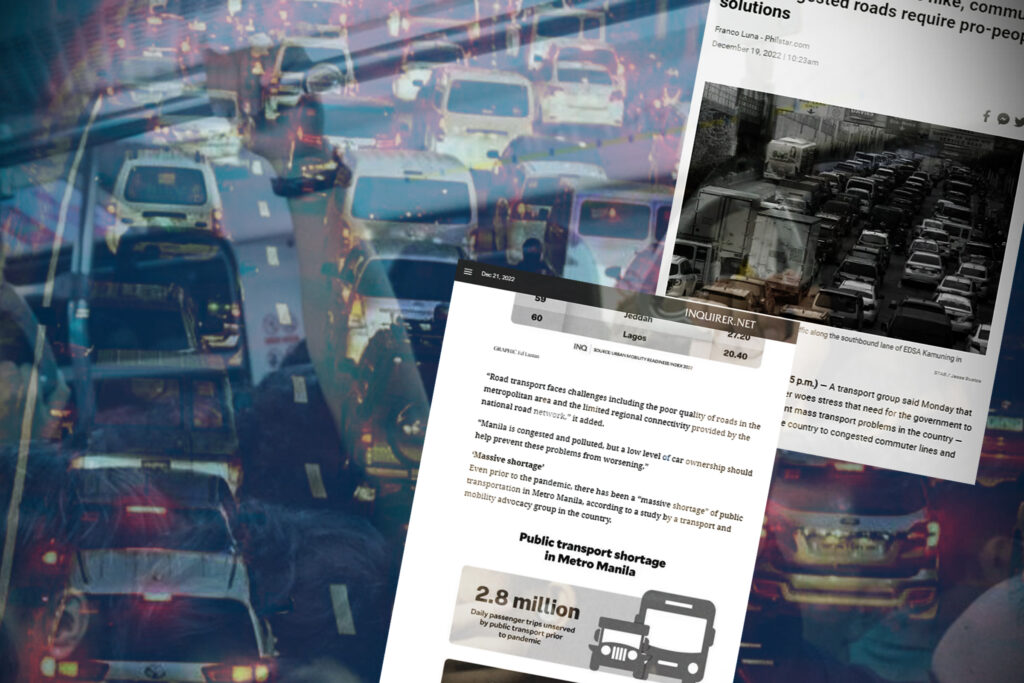Media report “pro-people” recommendations re transport issues

CHEERS TO Philstar.com and Inquirer.net for their comprehensive reporting on the country’s transportation woes. Their accounts stood out for their efforts in citing studies highlighting the real problems of the transportation system. They also presented the perspectives of the stakeholders involved in this issue — Public Utility Vehicle (PUV) drivers and commuters.
The Philippines has a high population density, and has a number of transportation challenges from the lack of infrastructure to the shortage in public transportation. These problems are often exacerbated by increased travel during the holidays. The government has attempted to address these issues through infrastructure projects like the long term Build, Build, Build Project, but progress has been slow and much work remains to be done.
In Philstar.com’s December 19 report, Mody Floranda, president of the transport group Pinagkaisang Samahan ng mga Tsuper at Operators Nationwide (Piston), called on the government to start formulating “pro-people” solutions to transportation issues.
The group stated that addressing the transportation crisis should involve both large-scale infrastructure projects and commuter-centric actions such as increasing the number of PUVs, expanding their routes to serve more commuters, supporting PUV drivers and small operators and reducing the number of private vehicles on congested streets.
Additionally, Piston suggested that the PUV modernization program focus on rehabilitating existing jeepneys to make them less polluting and more comfortable through local manufacturing. This approach would be more affordable for small operators than their purchase of imported mini-buses, and it would also support local industry and create more jobs for Filipinos.
In the same report, Philstar.com’s Franco Luna also cited Move Metro Manila (MMM), a commuter group, that recommended looking at making airport buses available to ease the vehicular bottleneck in the airport vicinity during the holidays.
The group also recognized efforts to improve the Service Contracting Program which has made the EDSA Busway service available 24/7 during the holiday season.
Lagging Behind
With the expressed sentiments of both the transport and commuter groups, the lack of commuter-centered solutions was emphasized in Inquirer.net’s report last December 20. Cristina Eloisa Baclig compiled results from the 2022 Urban Mobility Readiness Index by the Oliver Wyman Forum and the University of California, Berkeley showing how our country is far behind in public transportation across the globe:
- The Philippines ranked 58th out of 60 in the Urban Mobility Readiness (UMR) with a score of 31.2 percent. This means our country ranks low in preparedness for “mobility disruptors” such as the rise of ride-sharing services online.
- The Philippines is 48th out of 60 in the Sustainable Mobility sub-index, which evaluates the efforts of cities to create more environmentally friendly and sustainable transportation systems, scoring only 36.6 percent.
- Manila has the lowest ranking in the Public Transit sub-index, which measures the density, efficiency, and utilization rate of public transportation. Despite having various modes of public transportation available, such as jeepneys and metro lines, Manila ranked 56th out of 60 with a score of 31.9 percent.
Baclig also cited a policy paper released by Move As One Coalition, a transport and mobility advocacy group, titled “Fighting Transport Inflation: A Ten-Point Agenda.” The paper stressed that 14 percent of the bus and jeep transport power in Metro Manila has declined from 2012 to 2019; at the same time, there was a sudden 46 percent surge in private vehicle ownership.
Baclig highlighted key points of the coalition’s proposed 10-point agenda in addressing transportation hiccups: implementation of PUV-only hours on roads; reduction of private vehicle-only lanes; and widening of lanes dedicated for public transport.
The media must constantly report on the problems and challenges faced by commuters. The media can also highlight successful solutions and best practices in other countries, which can help inform and inspire policy makers.
Leave a Reply